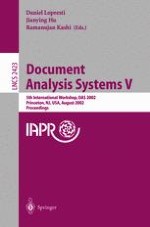2002 | Buch
Document Analysis Systems V
5th International Workshop, DAS 2002 Princeton, NJ, USA, August 19–21, 2002 Proceedings
herausgegeben von: Daniel Lopresti, Jianying Hu, Ramanujan Kashi
Verlag: Springer Berlin Heidelberg
Buchreihe : Lecture Notes in Computer Science
Enthalten in: Professional Book Archive
